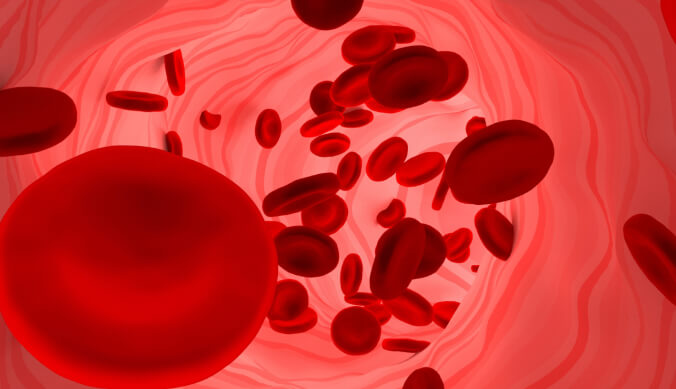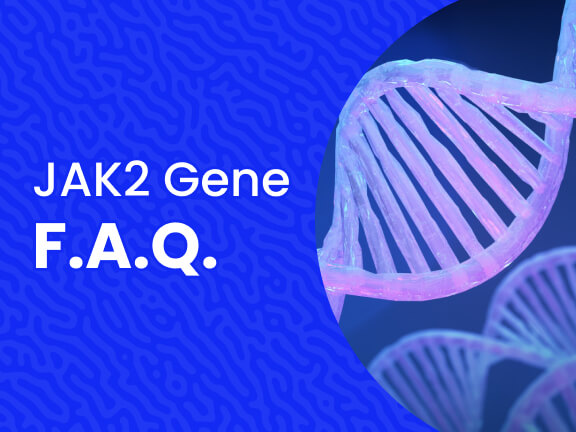JAK2-FAQs often highlight the critical role of the JAK2 enzyme in the regulation of cell growth and proliferation. JAK2 is a member of the Janus kinase family and is essential for transmitting signals from cytokine receptors to the cell nucleus. Mutations in the JAK2 gene, are closely associated with myeloproliferative disorders, such as polycythemia vera, essential thrombocythemia, and primary myelofibrosis.
JAK2-FAQs also cover the detection and treatment of JAK2-related conditions. Diagnostic testing for JAK2 mutations typically involves genetic assays, such as PCR and sequencing, performed on blood or bone marrow samples. These mutations lead to the constitutive activation of the JAK-STAT pathway, resulting in uncontrolled cellular proliferation and survival, which contributes to the pathogenesis of these diseases. Identifying these mutations is crucial for determining the appropriate therapeutic approach.
Does JAK2 positive mean cancer? A positive JAK2 mutation indicates an increased risk of certain blood cancers, but further testing is needed for a definitive diagnosis.
JAK2 mutation positive symptoms
Symptoms may include fatigue, night sweats, itching, weight loss, and symptoms related to increased blood cell production, such as headaches or dizziness.
JAK2 Gene Frequently Asked Questions
As cells grow and divide, the genes inside can mutate. The cell transfers this mutation to all newly formed cells, and various diseases may occur. In cases where the JAK2 gene is mutated, it causes myeloproliferative disorders such as polycythemia vera (PV), essential thrombocythemia (ET), and primary myelofibrosis (PMF).
Here we have answered your questions about the JAK 2 gene.
What Is the JAK2 Gene?
Janus kinase (JAK) is a family of intracellular, non-receptor tyrosine kinases (a type of enzyme that phosphorylates protein) that transmit signals via JAK-STAT. The JAK/STAT pathway transmits chemical signals from outside the cell to the cell nucleus.
Jack 2 is also a member of this family. It provides instructions for making a protein that promotes cells’ growth and division (reproduction).
What is a JAK2 blood disorder?

Typically, the JAK2 protein is found in the bone marrow and controls the production of blood cells. The blood cells produced have the potential to transform into red and white blood cells and platelets.
If JAK genes are mutated, the body can produce too many blood cells in certain blood conditions, including polycythemia vera (PV), essential thrombocythemia, and primary myelofibrosis. More than 90 percent of individuals with PV have a mutation of the JAK2 gene.
What does it mean if you are JAK2-positive?
A positive JAK2 V617F mutation test means that the person tested is likely to have a myeloproliferative neoplasm (MPN). MPN is a group of rare conditions that affect the bone marrow and result in excessive production of red blood cells, white blood cells, or platelets. Other tests, such as a bone marrow biopsy, may be needed to determine which MPN the person has and assess its severity.
How serious is the JAK2 mutation?
When the JAK2 enzyme overworks continuously, it leads to the overproduction of megakaryocytes cells. These megakaryocytes tell other cells to release collagen, and scar tissue begins to build up in the bone marrow (the descriptive sign of MF). Excess platelets can cause abnormal blood clotting (thrombosis), which leads to many signs and symptoms of essential thrombocythemia.
Mutations in JAK2 cause some bone marrow diseases. These are known as myeloproliferative neoplasms (MPNs), in which the bone marrow overproduces white blood cells, red blood cells, and/or platelets.
Some of the MPNs most commonly associated with JAK2 are:
- Polycythaemia vera (PV), where the bone marrow makes too many red blood cells
- Essential thrombocythaemia (ET), where there are too many platelet-producing cells (megakaryocytes) in the bone marrow
- Primary myelofibrosis (PMF) is also known as chronic idiopathic myelofibrosis or agnogenic myeloid metaplasia. There are too many platelet-producing cells and cells that cause scar tissue in the bone marrow.
JAK2 mutation should not be present in the normal population; it is a sign of a hematologic condition but not specific. It is more common in patients with polycythemia vera or myelofibrosis but also can be seen in those with myelodysplastic syndromes (MDS) and leukemias.
How often does ET progress to myelofibrosis?
Very rarely do patients with ET experience an evolution from ET to a more advanced blood disease. This evolution is sufficiently rare (within what is already a rare disease) that the estimates of the risk are imprecise but are thought to be on roughly 1-2 percent of patients with ET over a lifetime.
According to a study published in Jama Internal Medicine, progression to MF has been reported in ET with a cumulative risk ranging from 0.8 percent to 4.5 percent at ten years compared to previous literature.
In another study published in Nature, after a median delay of 8 years (latency range, 4-12 years), seven patients developed MF, of which 2 (acute myeloid leukemia) developed AML. Age, gender and mean platelet count at the time of diagnosis did not significantly affect the risk. The cumulative probability of MF conversion was 9.7 percent at ten years.
How long can you live with the JAK2 mutation?
In the study published in the National Library of Medicine, the data of 93 families consisting of 227 subjects were analyzed. (97 of them with polycythemia vera, 105 of them essential thrombocythemia, 14 have primary myelofibrosis and 11 of them chronic myeloid leukemia)
- In PV patients with a median follow-up of 12 years, overall survival was 83 percent at ten years and 37 percent at 20 years.
- Between a median follow-up of 8 years and 105 ETs, overall survival was 83 percent at ten years and 57 percent at 20 years.
How common is the JAK2 mutation?
The JAK2 mutation can be detected in approximately 98-100 percent% of cases of polycythemia vera, 50-70 percent% of patients with essential thrombocythemia, and 40-50% percent of cases of idiopathic myelofibrosis.
In addition, the mutation is also rarely detected in people with chronic myelomonocytic leukemia (CMML), primary acute myeloid leukemia (AML), myelodysplastic syndrome (MDS), and chronic myeloid leukemia (CML).
What are the symptoms of the JAK2 mutation?
Since more than half of people with MF and more than 90 percent of people with PV have mutations in the JAK2 gene, the clinical symptoms of JAK2 are similar to those of PV. These symptoms include headache, dizziness, weakness, weight loss, itching, and paresthesias.
What are the treatments for the JAK2 mutation?
The only FDA-approved (Food and Drug Administration) drug that works with JAK2 enzymes is ruxolitinib (Jakafi). This drug works as a JAK inhibitor, slowing down the activity of JAK2.






14 Comments
I have just been diagnosed with JAK 2 and have seen the labs but not been back to see my provider. Looking and reading things that I can.
Thanks for your message, we are sorry to hear about your diagnosis. We would be happy to help. You can learn more about available cancer treatment options and clinical trials here: https://hubs.ly/Q01yygDr0.
You can also contact one of our Patient Relations Coordinators via phone or email at 844-627-7246 & [email protected].
Hello,
my husband is diagnosed with Jak2 positive mutation.
what does it mean when the results say detected and percent positive is 7.99.
this number is consistently moving upward. 1 year ago it was 4.1.
i do not know what this means? please help.
thank you.
Thanks for your message. We would be happy to help. You can learn more about available cancer treatment options and clinical trials here: https://hubs.ly/Q01yygDr0.
You can also contact one of our Patient Relations Coordinators via phone or email at 844-627-7246 & [email protected].
Can you have JAK2 mutation and not have a MPN or any other disease ?
Thanks for your message. We would be happy to help. You can learn more about available cancer treatment options and clinical trials here: https://hubs.ly/Q01yygDr0.
You can also contact one of our Patient Relations Coordinators via phone or email at 844-627-7246 & [email protected].
hi same as above just diagnosed and I’m also recovering from stroke what does all this mean for me ?
Thanks for your message. We would be happy to help. You can learn more about available cancer treatment options and clinical trials here: https://hubs.ly/Q01yygDr0.
You can also contact one of our Patient Relations Coordinators via phone or email at 844-627-7246 & [email protected]
I have been diagnosed with JAK2 mutation since OCTOBER 2018. I was referred to Dr R.J. Grace FRCP, FRCPath Consultant Haematologist at Eastbourne Hospital. I have been prescribed several different drugs to lower the platelets level most of which have worked for a period of 5 to 6 months, maximum course of drugs 5/10 days seems to work, then platelet level start to rise and weakness/ discomfort comes over the body which seems to last for 24 to 48 hours. I sit down and do very little, recovery takes 24 hours.
Thanks for your message. We would be happy to help. You can learn more about available cancer treatment options and clinical trials here: https://hubs.ly/Q01yygDr0.
You can also contact one of our Patient Relations Coordinators via phone or email at 844-627-7246 & [email protected]
I wonder if the Jak2 mutation is seen more often in older people of Scandinavian heritage?? My first cousin is in her early 80s and was recently diagnosed with the mutation. I was diagnosed a few years ago at age 73,or 72. I am 3/4 Swedish and my cousin is half Swedish. she is currently taking hydroxyurea. I also took hydroxyurea for almost 3years, after my doctor did a bone marrow biopsy, she prescribed Jakafi!! It has really improved my quality of life!! I am so glad that it is covered by my insurance!
Thanks for your message. We would be happy to help. You can learn more about available cancer treatment options and clinical trials here: https://hubs.ly/Q01yygDr0.
You can also contact one of our Patient Relations Coordinators via phone or email at 844-627-7246 & [email protected]
Hi I have jack 2 cancer will it affect my working life what benefits can I get I work 30 a week
Thanks for your message. We would be happy to help. You can learn more about available cancer treatment options and clinical trials here: https://hubs.ly/Q01yygDr0.
You can also contact one of our Patient Relations Coordinators via phone or email at 844-627-7246 & [email protected]